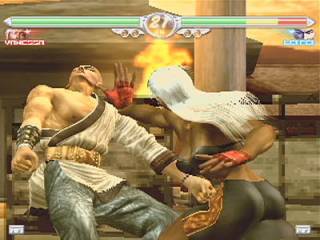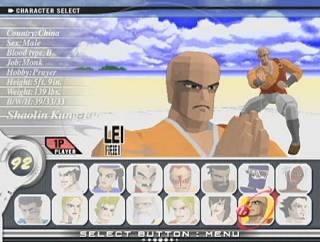Overview

Virtua Fighter 4 is a 3D fighting game developed by Sega-AM2 and released by Sega for arcades (using their Dreamcast-based NAOMI 2 hardware) on August 2001.
The fourth main installment of the Virtua Fighter series, Virtua Fighter 4 continues the trend of using the most powerful arcade hardware at the time for highly-detailed graphics. It also streamlines the series' gameplay mechanics while spearheading both internet functionality and persistent character costume customization in Japanese arcades.
Along with adding two new fighters to the roster (monk Lei-Fei and security guard Vanessa Lewis), the game revamps two game mechanics added in Virtua Fighter 3: evasion (by changing the dedicated Evade button to side-dashes and having mis-timed dodges leave the fighter vulnerable) and stage layouts (by reverting back to flat, squared arenas, and improving on the use of walled and differently-sized stages).
The game is best known for introducing online connectivity to arcade games, allowing Japanese arcade operators to connect their machines to Sega's VF.NET servers. This is combined with dedicated card readers (reading special "VF4 Character Access Cards") and cellular phones (connecting through the i-mode service) to allow players to track their stats, customize the appearance of the character linked to the card (by earning items through completing and winning matches), and rank up against all other players nationwide. Players can also use VF.NET to browse information about arcades that support it (including their player rankings and current machine status).
The game later received a home conversion for the PlayStation 2 in Japan on January 31, 2002, in North America on March 17, 2002, and in Europe on May 10, 2002. It features an advanced training mode (which provide gameplay tips and recommended character combos), the inclusion of character customization and stat-tracking from the arcade version, an A.I. learning functionality (where players can create an A.I. opponent that matches their techniques by sparring with them), and a special single-player ranked mode called "Kumite" (which has players challenged by an endless amount of computer-controlled opponents, each with custom appearances and A.I., made to resemble being challenged in a Japanese arcade).
It also received two major arcade revisions: Virtua Fighter 4: Evolution and Virtua Fighter 4: Final Tuned.
Characters
New Additions
- Vanessa Lewis - A security guard with an unknown origin, who fights with the martial art of vale tudo. She is unique in that she could switch to a second fighting style at-will, the other one being muay thai.
Returning Characters
The only fighter to not make a return is Taka-Arashi, with the development team claiming that his large stature could not work with the game's engine.
- Pai Chan - An action film star from Hong Kong, who fights with the agile martial art of Ensei-ken ("Lost Track Fist", or mízōngquán).
- Lau Chan - A famous chef from China and Pai's father, who fights with his own unique martial art of Koen-ken ("Tiger-Swallow Fist", or hǔyànquán).
- Kage-Maru - A traditional ninja from Japan, who fights with an agile form jujutsu (known as Hagakure-ryu jujutsu).
- Shun Di - An elderly herbal doctor from China, who fights with the martial art of Sui-ken ("Drunken Fist", or zuìquán).
- Lion Rafale - A wealthy college student from France, who fights with the martial art of Tourou-ken ("Praying Mantis Fist", or tánglángquán).
- Dural - A mysterious metallic gynoid and the game's bonus boss using techniques from all other fighters. Only playable as an unlockable in the PS2 version.
Virtua Fighter 10th Anniversary

To celebrate the series' 10th anniversary, Sega developed a special version of the PS2 version of Virtua Fighter 4: Evolution to make it resemble the original 1993 Virtua Fighter. It was included as a bonus add-on in the North American PS2 version of Virtua Fighter 4: Evolution, while in Japan it was sold as a separate release disc (as Virtua Fighter 10th Anniversary).
The Japanese version of the game was originally sold on November 28, 2003 and included a supplemental book (Virtua Fighter 10th Anniversary: Memory of Decade) and interview DVD. This version was later re-released on February 8, 2007 as a pre-order bonus for the PlayStation 3 version of Virtua Fighter 5.
Gameplay Differences
The gameplay is nearly identical to that from Virtua Fighter 4: Evolution, with some differences:
- Each character uses a low-polygonal model, with those from the original Virtua Fighter nearly identical to their original appearance.
- All stages are identical to their original Virtua Fighter counterparts, and thus the game only uses one stage layout (with no walls). All music, as well as the in-game display, are also from the original Virtua Fighter.
- Only Arcade and Vs. modes are included. For Arcade, it includes two arcade progression routes, one based on the original Virtua Fighter route (Jacky, Jeffry, Sarah, Kage, Pai, Wolf, Lau, Akira) and one using all remaining characters in order of their first appearance (Akira, Lion, Shun, Aoi, Lei-Fei, Vanessa, Brad, Goh). The latter route uses the same stage and soundtrack progression as the former.
- The in-game credits list all games in their release order.
Log in to comment